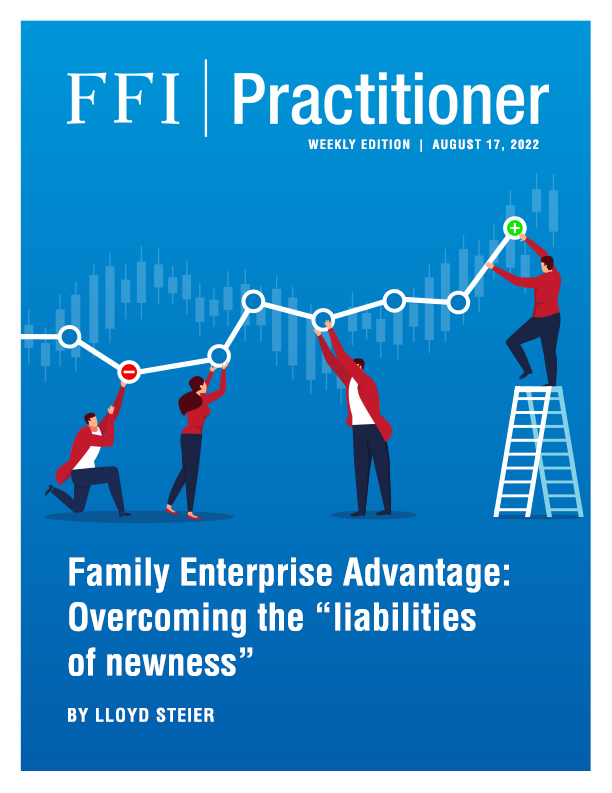
Overview of the Liabilities of Newness
New ventures (both family- and nonfamily-owned) face a unique set of challenges at the time of their founding. The American sociologist, Arthur Stinchcombe (1965, p. 148) labelled these challenges the “liabilities of newness.” These liabilities have four elements:
- Organizational actors must learn new roles.
- New roles and routines must be invented.
- New organizations must rely heavily on social relations among strangers.
- These new relationships are often much more precarious than the established relationships found in older organizations.
These four elements require that entrepreneurs both learn new routines and establish new relationships, consistent with the strategic intent of the new venture. However, for family firms, their inherent “familiness” can potentially offer the new business a unique bundle of resources helpful in both overcoming the liabilities of newness as well as the ability to derive a long-term competitive advantage.

Real World Family Enterprise Examples
Two examples help demonstrate how family ownership can offer a powerful repository of useful resources in a firm’s founding and growth. Both were new ventures within the global packaged salad industry—a market that has enjoyed tremendous growth in recent years. I became involved with the first company as part of a large research project on entrepreneurship. It was founded by two enthusiastic engineers based on the concept of hydroponically growing and selling bagged lettuce through retail outlets in Canada. The company was eventually funded by a venture capital syndicate. Unfortunately, this promising firm failed when the venture capitalists did not approve late-stage financing. In retrospect, the founders encountered numerous problems associated with the “liabilities of newness.” They were preoccupied with the growing process and issues related to production, they were unable to negotiate appropriate shelf space with grocery retailers, and their relationships with their venture capital partners broke down—the syndicate created some delays in releasing funding in a timely fashion after milestones had been reached.
Alternatively, another firm within the same industry had a markedly different experience mobilizing familial resources. I was introduced to this Australian-based company at a family business conference in Europe. The founder was being celebrated for creating a successful firm (close to a billion dollars in sales) in the bagged lettuce industry. How did he become successful? To paraphrase his explanation, “My father was in the produce distribution industry in Australia. While visiting the U.S., I noticed bagged lettuce was popular and I thought it might sell in Australia. So, I came home, ‘chop, chop’, put it in a bag, and sold it.” This process sounds remarkably simple compared to the earlier example. In reality, the Australian entrepreneur was able to leverage a complex array of resources, relationships, and routines. This entrepreneurial phenomenon, the creative mobilization and bundling of familial resources, occurs throughout the world.
Sidebar
by Lloyd Steier
In this article, Lloyd Steier puts the data on family enterprise longevity in a new perspective.
As part of a research project I conducted with YPO in Canada, I identified members who came from business families and conducted a series of interviews. Initially, I used a standard entrepreneurship interview protocol that began, “Tell me about your firm.” The most common response I received to this question was, “Which one?” I soon adjusted my protocol as it was clear that, although these individuals may have relied on familial resources in the venture creation process, they were engaged in “serial” or “portfolio” entrepreneurship. One interviewee invoked a “seed metaphor” as a way of thinking about familial resources. To paraphrase his example:
Concluding Thoughts for Practitioners
For all firms, competitive advantage is a matter of mobilizing and leveraging resources consistent with strategic intent. Family firms continue to survive and thrive throughout the world because they are doing something right. The liabilities of newness concept and its associated propositions offer a helpful way of thinking about what these advantages might be. For advisors, working with family firms requires establishing an appreciation of these resources.
Questions to Consider
- Are family business advisors purveyors of doom and gloom regarding the viability of family businesses or should these practitioners view them as rich repositories of resources that can be leveraged for business—and societal—advantage?
- Do advisors devote too much attention to dividing the proverbial pie when we might be better focused on ways of expanding it?
- Do advisors focus overly on individuals while undervaluing the family system and long-term processes?
- Do advisors view family legacy as a constraining variable, as opposed to an enabling one?
The liabilities of newness concept offers a useful way of thinking about—and acting upon—family advantage. Ultimately, it offers practitioners an optimistic view of family firm survival and success.
References
Baron, J. & Lachenauer, R. (2022, April 19). Success or Failure? Rethinking the three generation rule. FFI Practitioner. https://ffipractitioner.org/success-or-failure-rethinking-the-three-generation-rule/
Steier, L. (2014, February 26). Family Advantage: Why all the doom and gloom. FFI Practitioner. https://ffipractitioner.org/family-advantage-why-all-the-doom-and-gloom/
Stinchcombe, A. L. (1965). Social Structure and Organizations. In J.G March (Ed.), Handbook of organizations (pp. 142–193). Rand McNally.




